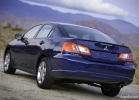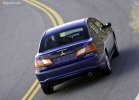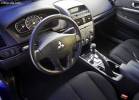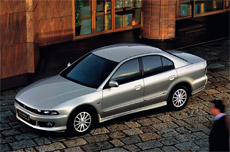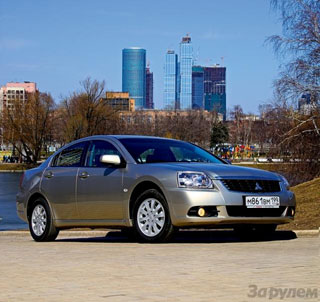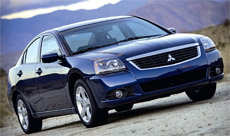Mitsubishi Galant test drive since 2008 sedan
Triple car Banzai
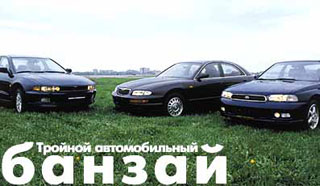
Our test was held by three Japanese models. All sedans of the same class of close sizes and with engines of a 2.5 -liter working volume. Two, Galant and Mazda Ksedos-9 front-wheel drive, third, Subaru Legasi, all-wheel drive. The latter fell into this three for a reason: I wanted to identify the advantages of a 4x4 wheelchain machine with an unknown drive, and not abstractly, but against the background of models with front leading wheels. True, it would be easier to feel the difference in mud and slush, but on the day of the test we were expected to be sunny weather and dry road. Mazda, like two other machines, should have been with a mechanical KP, but, alas, only a modification with an automatic machine was at hand.
So, cars at the start of Banzai!
Lev Shugurov
photo by Alexei Skirdov
 General assessment of the design
General assessment of the design As you know, outwardly, Japanese machines do not differ in special diversity. It seems that their appearance is formed by a computer with a special prohibition program not to deviate from the average norms, sizes, proportions, and forms. However, in the models of Galant and Legashi, the grain of individuality was originally laid, which gave healthy sprouts to the eighth generation (namely about these machines).
 In the engineering aspect and Galant and Legashi, they are worked out very carefully and literally in all nominations (we will use this fashionable cinema term now) turn out to be a little in front of their classmates. The highest technological culture is manifested in very uniform, extremely narrow gaps between body panels, and in impeccable upholstery of seats and interior, and in neat welding seams under the rugs shorter, in all, in every little things.
In the engineering aspect and Galant and Legashi, they are worked out very carefully and literally in all nominations (we will use this fashionable cinema term now) turn out to be a little in front of their classmates. The highest technological culture is manifested in very uniform, extremely narrow gaps between body panels, and in impeccable upholstery of seats and interior, and in neat welding seams under the rugs shorter, in all, in every little things. Galant, probably, has one of the best V-shaped six. At all modes, it works softly, without vibrations and a torque, apparently surpasses many of its classmates.
 Subaru Legasi is generally a very outstanding design. The car has not only a constant drive to all wheels, but also an opposite four -cylinder motor, frameless doors (glass fall directly on the seal). In general, from the technical point of view of Legashi, the machine is unconventional.
Subaru Legasi is generally a very outstanding design. The car has not only a constant drive to all wheels, but also an opposite four -cylinder motor, frameless doors (glass fall directly on the seal). In general, from the technical point of view of Legashi, the machine is unconventional. Mazda Ksedos-9 model, designed for a business person. Its designers keep up with the times, but nothing more.
The first tour of our test brings Galanta and Legashi 8 points, Ksedos-9 7.
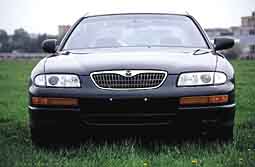 Suitability for Russian conditions
Suitability for Russian conditions There was an all -wheel drive legashi out of competition. Models with front drive wheels are not bad, but ...
Fifteen and sixteen-inch wheels are quite calmly perceived by potholes, cracks in the asphalt and other gifts of Russian roads. This is an undoubted plus. The road clearance of Kedos-9 is small. Legasi has quite acceptable. Both cars in the front wings have a barrier of the barrier on the path of the pebbles and sand flying from under the front drives. Useful thing.
Legashi receives 9 points, the rest is 7.
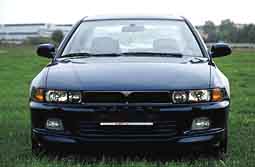 Ergonomics. Planting-casting
Ergonomics. Planting-casting On Galanta, a strong slope of the windshield gives the opening of the front door a not very convenient shape. But having learned to dive your head into the salon, you quickly forget about this inconvenience. The distance from the head of the driver to the ceiling is minimal, but above the heads of the rear seat passengers are quite spacious.
In the Legashi salon, a different picture. Between the driver’s head and the ceiling, the gap is provided, but the jamb of the rear door at the entrance and exit seemed low to us.
As for the Ksedos-9, the situation is generally favorable there, and the seats, of course, are the best direct hint of the representative ambitions of this car, although in the front seats the side support clearly leaves much to be desired.
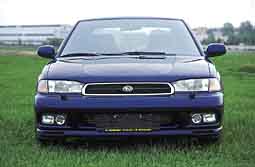 The steering wheel for all machines is adjustable along the angle of inclination, and all the buttons, levers and toggle switches are located very conveniently as if they themselves lie down in the hand. But most of all we liked the driver's site in Legashi, and the steering wheel of Momo finally bowed the scales in favor of Subaru.
The steering wheel for all machines is adjustable along the angle of inclination, and all the buttons, levers and toggle switches are located very conveniently as if they themselves lie down in the hand. But most of all we liked the driver's site in Legashi, and the steering wheel of Momo finally bowed the scales in favor of Subaru. Ksedos and Galant of 7 points, Legasi 8.
Shodal qualities
The habiting of the wheels at the gallery is quite soft and absorbs obstacles: seams and cracks on the asphalt, hillocks, cavities. Road noise is minimal. But this suspension is most likely not oriented for high -speed turns. This time, the company Mitsubishi abandoned the simpler production of MacPherson, preferring a multi -link independent suspension of all wheels.
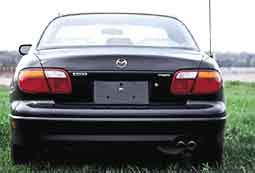 The steering mechanism, equipped with a hydraulic power control, seemed to us somewhat oak. So far, the company has not decided to use an amplifier with a variable (depending on speed) degree of amplification.
The steering mechanism, equipped with a hydraulic power control, seemed to us somewhat oak. So far, the company has not decided to use an amplifier with a variable (depending on speed) degree of amplification. The rolls during the movement of the car are small, but the Mazda turned out to be even smaller. And the stability of Kedos in corners caused general admiration.
A very large stroke of the Legashi suspension excludes breakdown even on the coarse road. Banzai! The suspension is very energy -intensive, well, the shock absorbers, of course, are beautiful. The front wheels (as, indeed, on the Kedos-9) are suspended according to the MacPherson scheme, and therefore the road noise echoing in the cabin with a weak echo.
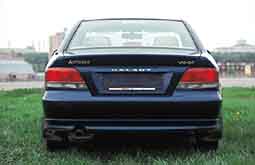 On steep turns, the suspension Legasi left a favorable impression, but at speeds of more than 80 km/h the driver had to use the entire arsenal of his skill.
On steep turns, the suspension Legasi left a favorable impression, but at speeds of more than 80 km/h the driver had to use the entire arsenal of his skill. And appropriate ratings: 9 points for Legasi and Ksedos., 8 points for gallant.
Dynamic and economic indicators
Galant is very high -speed and receiving machine. A purely switching gearbox contributes to good accelerating dynamics. The brakes (all four disk) are not perceptible, but they work flawlessly. It is also worth paying attention to the presence of ABS and traction control. This, however, is equipped with two other cars.
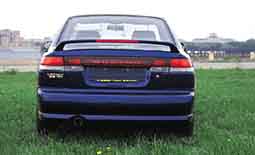 It is especially necessary to say about the Legashi motor. In the tested Trinity, it is the least powerful: only 150 horses, but meekly allows you to move out of place in third gear (or even on the fourth). The tachometer shows about 1000 rpm. Maximum torque falls at 4000 rpm.
It is especially necessary to say about the Legashi motor. In the tested Trinity, it is the least powerful: only 150 horses, but meekly allows you to move out of place in third gear (or even on the fourth). The tachometer shows about 1000 rpm. Maximum torque falls at 4000 rpm. Legashi has the highest fuel consumption, but this model is the only one of the trinity with a constant (non -clogged) drive to all wheels.
The high-speed, accelerated and economic indicators of Ksedos-9 due to automatic checkpoints did not stand out among classmates.
Here, with a small advantage, Galant (8 points), followed by Legashi and Ksedos-9 (7 points each) leads.
 Comfort in the cabin
Comfort in the cabin Let's start with Galant. The front seats are regulated by electric motor, which move the pillow up and down, back and forth and change the angle of inclination of the back.
The doors are equipped with electric windows. The design with a soft bite, not impending the fingers or arm that accidentally hit between the glass and the frame.
However, all three machines are provided with a gentleman's set of its class: electric windows, central control of door locks, climatic control, adjustment of external mirrors with electric drive, cruise control. But there is no hatch in the roof on Kedos-9. Legashi has heated wipers: a useful thing, especially in early spring and late autumn.
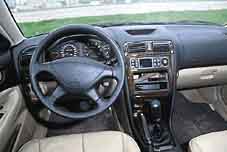 On Ksedos-9, the door threshold turned out to be a pleasant surprise, and Galant had a ceiling lamp for reading in the back seat.
On Ksedos-9, the door threshold turned out to be a pleasant surprise, and Galant had a ceiling lamp for reading in the back seat. The leather upholstery of the seats (as in Galanta and Legasi) other drivers are proud of, while others do not like it, preferring fabric, velor or (as on Ksedos-9) from a leather substitute. But the most comfortable seats, of course, have Mazda.
All cars have been carried out musical training (speakers are delivered), but only the Mazda is regularly installed a radio and a CD player.
We give grades: everyone 8 points.
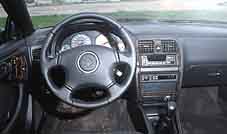 Aesthetics
Aesthetics Galant, of course, stands out among Japanese classmates, in no way inferior to European and American models. Of course, everything is very subjective here, but European journalists immediately appreciated the narrow headlights of the Japanese new items, by the way, creating, by the way, a more powerful (25%) light flow than the previous gallant of the seventh generation.
It is also impossible to ignore the fact that artists, together with designers, have very much improved the aerodynamic indicators of the car: the factor coefficient (CX) decreased to 0.29. As a result, fuel consumption at speeds is higher than 100 km/h decreased.
 The indisputable dignity of Legasi well -balanced ratio of body volumes. A rather low hood was possible not only thanks to narrow block-framents, but also for a compact opposition engine (four cylinders located horizontally, like a beetle on the Volkswagen). The modification of the Legasi GX with a spoiler installed on the trunk looks especially piquant.
The indisputable dignity of Legasi well -balanced ratio of body volumes. A rather low hood was possible not only thanks to narrow block-framents, but also for a compact opposition engine (four cylinders located horizontally, like a beetle on the Volkswagen). The modification of the Legasi GX with a spoiler installed on the trunk looks especially piquant. The graceful grille of the radiator, clean lines of the body with slightly pouting sidewalls show that the Ksedos-9 is a sports nature, and the most overall dimensions make him perceive nine as a representative of a representative class, although not 100%. Banzai! But in the cabin, a dull combination of gray and black colors visually create a feeling of crowding. Another thing is the light-beige upholstery of the Galant salon. Sunny, spacious. True, such upholstery
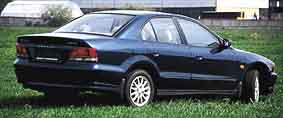 too, as they say, marked.
too, as they say, marked. Estimates: Galant 8 points, Legasi and Ksedos-9 to 7.
Safety
On Galanta, not only inflatable airbags for the driver and his neighbor, but also two pillows in the sidewalls of the front seats. Galant is the first serial Japanese car with side pillows. Banzai! Four seats of seats, modern seat belts, protective bars in the doors, ABS and traction control are itself. There are no side pillows on Legasi and Ksedos-9, but the rest of the same set.
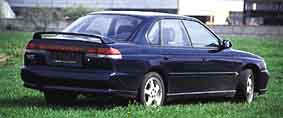 Galant has 8 points, Legashi and Ksedos-9 7.
Galant has 8 points, Legashi and Ksedos-9 7. Price
All cars have engines with a 2.5-liter working volume, 5-speed gearboxes, a body of close size and internal volume. The equipment of machines in nomenclature and quality is also almost no different. Of course, the all -wheel drive model Subaru Legasi should be a little more expensive. In terms of the ratio of consumer qualities and prices for the Russian market, Galant (8 points) is most suitable, then Legasi (7 points) and Ksedos-9 (6 points) go.
 Big Japanese
Big Japanese Alexander Potekhin
The market, whatever it is, creates the main competition. This gives us, consumers, quality products. Japanese automakers have long won a strong place in the world market, and the eastern breeze forces Europeans and Americans to protect all new car models, technologies, design, etc.
On this day, we tested three Japanese classmates at Khodynka: Mazda Xedos-9, Mitsubishi Galant, Subaru Legacy. All four -door five -seater sedans with multi -valve engines (working volume up to 2500 cm3). Thrushell trunk, leather salons, full electric packets, all amenities for the driver and passengers. Of course, the steering hydraulic power steering, the ABS system (in Mitsubishi Galant, also has an anti -wings system). The rivals came to tests in alloy wheeled wheels: Mazda and Galant have 15-inch, Subaru has 16-inch. The all -wheel drive Legasi of the Podrodovo ultramarine color proudly carried a real racing anti -wing on the trunk lid. According to the style of the body, Galant resembles BMW, but does not lose his face. Xedos almost English racing color with an abundance of chrome details and rounded shapes could compete with classmates in speed, but in style it was more suitable for a representative class. A four-speed machine in a block with a V-shaped six met my expectations. Almost a silent motor, a decent dynamics and a maximum speed in the fourth gear 180 km/h when accelerating from a place of 1000 m. True, the machine is a little thoughtful and harsh. On the stop and in a high-speed 90-degree turn, which could be drove without sliding at a speed of 110 km/h, many independent front and back suspensions work very well. Light, with a small gear ratio, steering is quite informative.
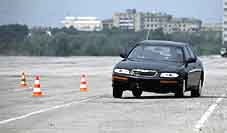 ABS at speeds up to 120 km/h acts normally, but at a greater speed I would prefer more effective brakes. The brakes of Galanta showed themselves in the same way. But Galant’s rolls have a little more than competitors. Apparently, this is due to the fact that Galant comes to the Russian market with increased road clearance. A decrease in clearance by 3-4 centimeters would improve the stability of the car, would give it a more muscular appearance and, not to the detriment of comfort. But I would not modify the motor and a manual gearbox: these units are quite suitable for each other. A multi-valve V-shaped six is \u200b\u200bheard in the car’s cabin exactly as much as necessary, and disperses Galant quickly than classmates (185 km/h per 1000 meters of distance). The gearbox lever is very accurate and stands still. The gear ratio of the steering in the galant is larger than that of the rivals, which, coupled with noticeable rolls in corners, slightly spoils the overall impression of this very good car.
ABS at speeds up to 120 km/h acts normally, but at a greater speed I would prefer more effective brakes. The brakes of Galanta showed themselves in the same way. But Galant’s rolls have a little more than competitors. Apparently, this is due to the fact that Galant comes to the Russian market with increased road clearance. A decrease in clearance by 3-4 centimeters would improve the stability of the car, would give it a more muscular appearance and, not to the detriment of comfort. But I would not modify the motor and a manual gearbox: these units are quite suitable for each other. A multi-valve V-shaped six is \u200b\u200bheard in the car’s cabin exactly as much as necessary, and disperses Galant quickly than classmates (185 km/h per 1000 meters of distance). The gearbox lever is very accurate and stands still. The gear ratio of the steering in the galant is larger than that of the rivals, which, coupled with noticeable rolls in corners, slightly spoils the overall impression of this very good car.  PBS at Galant works on the principle of yes. So you will not succeed in starting to start with a box on dry asphalt, soil or snow.
PBS at Galant works on the principle of yes. So you will not succeed in starting to start with a box on dry asphalt, soil or snow. Subaru with your intention to be a skill fights in the usual way all wheel drive, which allows you to get very good characteristics of the controllability of the car in the Cloth conditions. Yes, indeed, acting with the steering wheel and gas, the experienced driver will receive a manageability reserve in critical situations, but this should not be abused.
On Subaru, I was able to drive a rearrangement and turn 15 km/h faster than on front -wheel drive Mazda and Mitsubishi, but only after I used the skills of a sports driving style that is not always suitable for ordinary trips. By the way, do not forget that all -wheel drive cars accelerate on a slippery road much faster than the classic or front -wheel drive, but stop when braking in the same way.
 In a multi -valve four -cylinder opposition, Subaru Legashi power is less than the six Mazda and Mitsubishi, but a very good torque. The checkpoint is a little long for gear ratio, but it turns on very well. Mcpherson suspension harsh characteristics are quite combined with the capabilities of all -wheel drive transmission, and a smaller number of silent blocks make the suspension more reliable and less expensive in maintenance.
In a multi -valve four -cylinder opposition, Subaru Legashi power is less than the six Mazda and Mitsubishi, but a very good torque. The checkpoint is a little long for gear ratio, but it turns on very well. Mcpherson suspension harsh characteristics are quite combined with the capabilities of all -wheel drive transmission, and a smaller number of silent blocks make the suspension more reliable and less expensive in maintenance. I liked the brake system of Legasi, equipped with ABS than that of Mazda or Mitsubishi. The lack of motor power is compensated by the excellent stability of the machine in a sports driving style. The racing anti-wing on the trunk lid is complemented by 16-inch wheels.
In general, all classmates left a good impression and are standing each other. I tried to convey the difference in accents laid down in the design and style of cars, and the one who buys himself must decide what to prefer. The car, like clothes, needs to be chosen to your liking. Tests have shown that middle -class Japanese clothing is quite practical, stylish and correct with respect to the indicator Price safety practical quality.
Source: Cars

